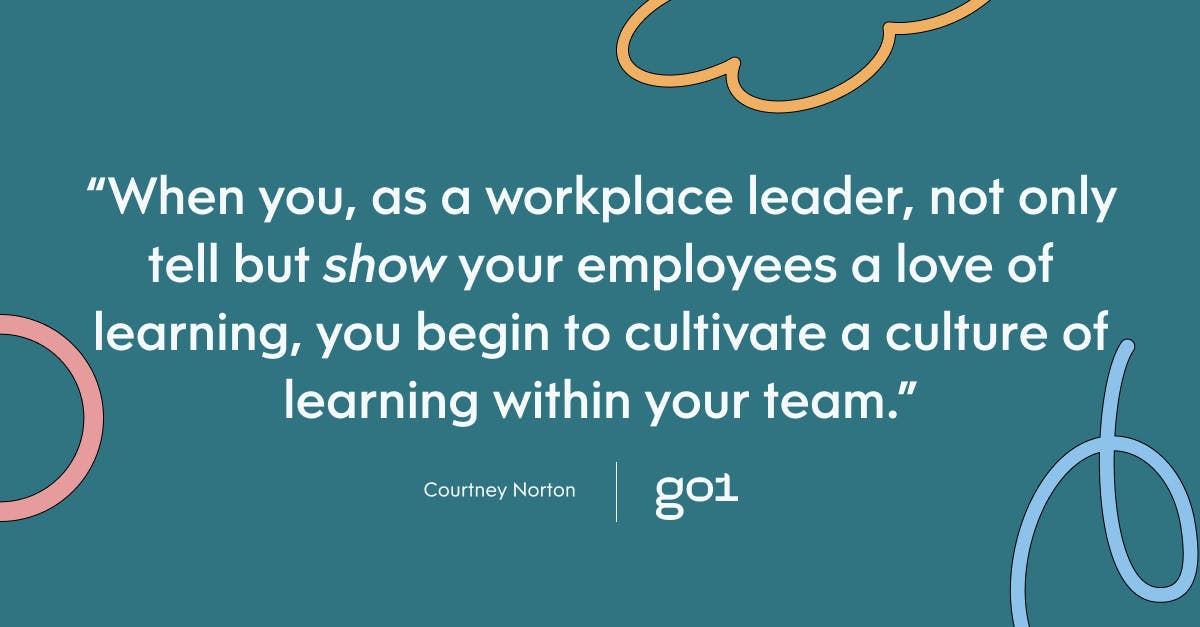
Helping employees to love learning beyond compliance

While most employees are content to complete mandatory compliance training, there is so much more potential for workplace learning beyond the ticking of a box.

But how can workplace leaders help their employees to not only reach that extra learning potential, but to actually want to reach that potential?
The benefits of creating a culture of learning
If you’re a people manager or leader, you might be wondering if it’s worth encouraging your team members to do more than the required amount of workplace learning. After all, you’ve got team targets to reach, meetings to attend, and what seems like an endless stream of emails to catch up on. Why take time away from those things to add yet another thing to your plate? We’ll tell you why.
Encouraging employees to dig into additional workplace learning beyond what’s required will help to cultivate a culture of learning. Within this positive environment, people are far more likely to improve existing skills, or even acquire brand new ones, making them an even more valuable asset to your team and organisation.
Acquiring new skills and upgrading old ones is particularly important during times of transformation, helping employees adapt to changing conditions.
A love of learning in the workplace can also greatly assist with employee retention, particularly with members of Gen Z. In fact, 60% of 16-to-24-year olds admit that they have left a job due to limited growth opportunities. When employees are provided with learning opportunities, as well as the motivation, they’re more likely to stay with the same company.

Practical steps towards a team-wide love of learning
It’s one thing to tell your team all about how learning at work will help them expand on their workplace skills. And sure, just telling them might work, but there’s a much more effective way to do things - and that’s leading by example.
When you, as a workplace leader, not only tell but also show your employees your love of learning, you begin to cultivate a culture of learning within your team. To put it even more simply, enthusiasm is contagious. When your team can see that you are excited about learning beyond what’s required as part of compliance, then they’re more likely to get excited as well.

Another step that workplace leaders can take to help employees love learning is to encourage curiosity. Is there a gap in the industry you and your team have been thinking about for a while now? Have you ever wondered if your team might do well from working more closely with another team in your company? Has a member of your team read something interesting online that they think might be helpful to know more about? When you and your team begin to ask these questions, it gets the ball rolling about what you can do to help answer these questions. What is learning if not asking and answering questions?
While deadlines of some description are an expected part of many roles across a variety of industries, that doesn’t mean we should add even more of them to workers who likely already have busy schedules. When workplace leaders take the pressure of deadlines away from learning in the workplace and allow their employees to learn at their own pace, the attitude around learning becomes much more relaxed. Employees will be able to begin a learning module on a topic they’re interested in without having to worry about getting it finished within a certain time frame. Without this, employees may be unlikely to start new learning tasks for fear that the tight deadlines might take away from more highly prioritised work.

Similarly, the introduction of micro-learning also takes some of the pressure out of workplace learning. Knowing that a learning task may only take 10 minutes out of the day makes the tasks not only feel more manageable to complete, but also makes it easier for employees to fit them in to their busy workday without taking too much away from their other work tasks. Naturally, when something is more relaxing, it becomes much easier to actually enjoy doing it, rather than feeling like it’s a task that ‘has to be done’.
No one knows everything and that’s okay
Make no mistake, the goal of helping employees to love learning beyond compliance is not to help them know everything. It’s more about the acknowledgment that learning is a continuous process, that there’s always more to learn and that when we enjoy what we’re learning about, we’re going to want to keep doing it.
Keen to learn more about how you can level up your compliance training and make learning fun? Check out this blog.
For more insights, be sure to subscribe to the Go1 newsletter to stay on top of all the latest L&D trends. Or, you can book a demo today to find out how Go1 can help with your team’s learning needs.




